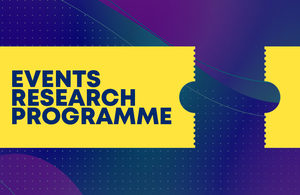UK Government publishes final Events Research Programme reports
The Government has today published its final reports from the world-leading Events Research Programme (ERP).
The unprecedented programme of research has been instrumental in the successful reopening of the live events sector, allowing audiences across the country to get back to attending live events safely.
The findings are the latest in a number of significant achievements by those involved in the programme. Scientists and researchers have developed a large body of publicly-available evidence on transmission at large events, contributing to the development and implementation of Government policy on the reopening and running of live events in a COVID-secure way.
Today’s reports summarise the findings of the programme’s Behavioural and Environmental studies, a transmission study led by the London School of Hygiene and Tropical Medicine, and a summary note encompassing the main learnings from the programme, including operational findings on COVID-status certification.
The transmission study provides further analysis of COVID-19 test data related to ERP events. The Data Dashboard (link) published by the Department for Digital, Culture, Media and Sport on Friday 20 August supplements this work. This study looks into the risk of transmission associated with attending events in the third phase of the ERP, and found that outdoor unstructured ERP events, specifically festivals, posed the highest increased transmission risk from events examined as part of the programme.
As noted in today’s publication, numerous factors were likely to have contributed to the higher transmission risk at these events, including high rates of unvaccinated attendees, community prevalence at the time of the events studied, the structure of the events, and the behaviour of attendees leading up to and after attending these events. Therefore, the results may not be applicable to other contexts.
The Environmental and Behavioural note published today provides further analysis of risk factors and makes recommendations for venues and event organisers. This includes how they should give ongoing consideration to ventilation, occupancy and movement within an overall risk assessment tailored to each venue.
The summary note published today provides an overview of the Events Research Programme from inception to conclusion. It looks at the objectives of the programme, the research studies conducted, the impact of certification as part of it and further considerations when developing strategies to manage transmission risk.
Minister for Sport, Tourism, Heritage and Civil Society Nigel Huddleston said:
The Events Research Programme broke new ground on the size and scale of scientific research undertaken at live events and has undoubtedly contributed to the early reopening of our crucial business, sporting and cultural events sectors.
The programme has provided an important template for event organisers the world over to continue to be able to plan their events safely and that’s great credit to the scientists behind this world-leading study.
Professor Dame Theresa Marteau, Chair of Events Research Programme Science Board, said:
It has been a pleasure to lead the Science Board that has overseen this large-scale science-lead programme researching the risk of transmission from attending live events to help people get back to doing the things they love.
We have gathered large amounts of data that can be used by the scientific community worldwide, event organisers and government for the best understanding to date of the risk of transmitting coronavirus at live events and how we can best keep this risk low.
The Events Research Programme ran for four months, encompassing 31 pilots and welcoming back over two million people to the live events sector.
Running over three complete phases, the ERP used cutting edge scientific methods to study audience behaviour, ventilation, certification and the use of Non-Pharmaceutical Interventions (NPIs) such as face masks and social distancing to examine how the risk of Covid-19 transmission could be reduced and audiences returned safely.
Over 750 temporary cameras captured thousands of hours of footage, alongside the extensive monitoring of CO2 in 179 individual spaces using 370 monitors all deployed in one of the largest evidence gathering programmes ever seen in the live events sector.

